A Deep Dive into Statistical Concepts: Study Designs and Analysis
VerifiedAdded on 2022/08/29
|6
|1128
|20
Report
AI Summary
This report delves into crucial statistical concepts and study designs relevant to public health and research. It begins by defining confounding variables and their impact on experimental results, alongside methods to mitigate their effects such as random sampling and control variables. The report then explains confidence intervals, their role in inferential statistics, and how they provide a range within which a population parameter is likely to fall. Following this, the report details case-control studies, outlining their methodology, use of odds ratios, and advantages in studying rare diseases. Finally, it examines cohort studies, differentiating between prospective and retrospective designs and highlighting the utility of risk ratios. The report emphasizes the importance of selecting appropriate study designs and understanding statistical measures for effective research and analysis.
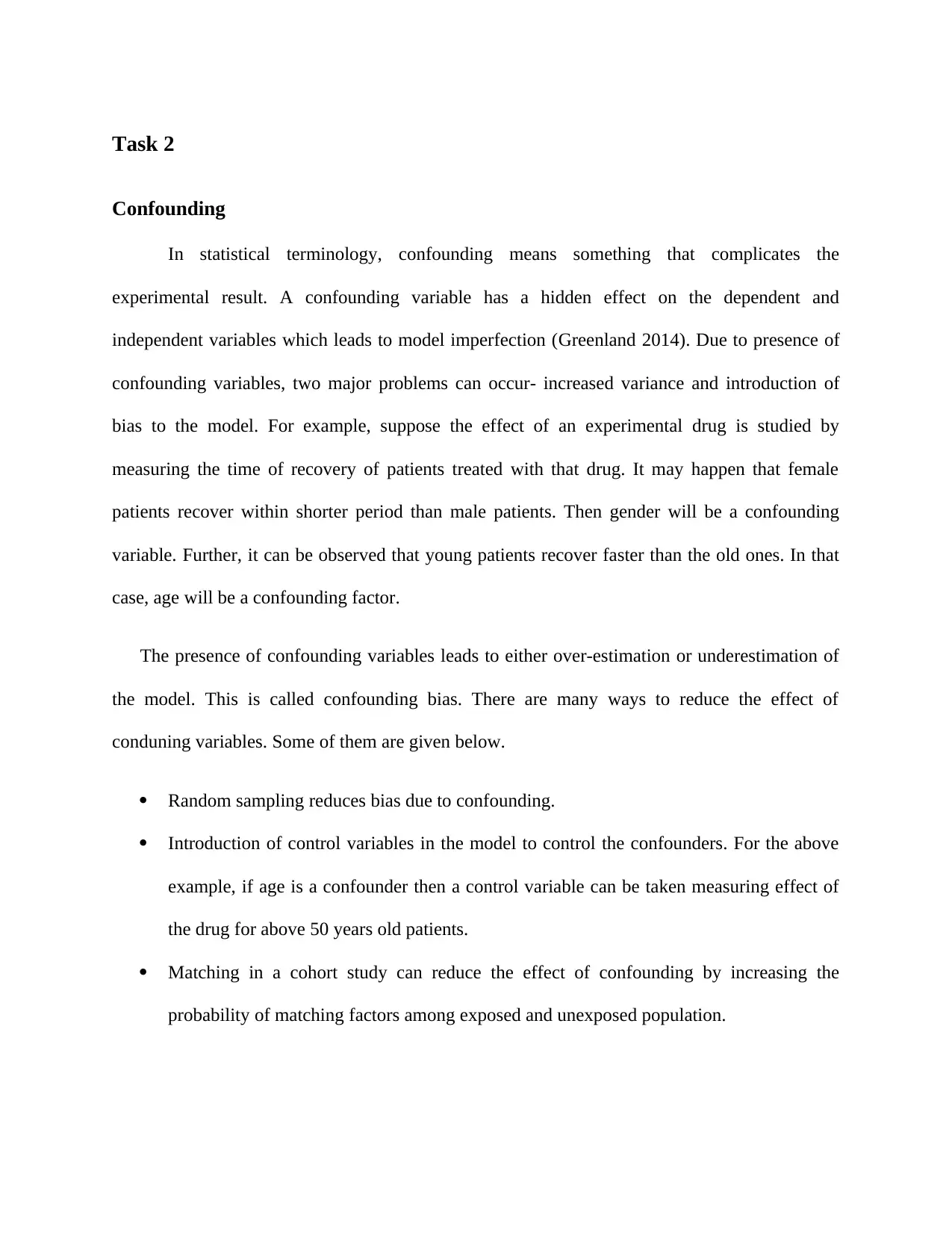
Task 2
Confounding
In statistical terminology, confounding means something that complicates the
experimental result. A confounding variable has a hidden effect on the dependent and
independent variables which leads to model imperfection (Greenland 2014). Due to presence of
confounding variables, two major problems can occur- increased variance and introduction of
bias to the model. For example, suppose the effect of an experimental drug is studied by
measuring the time of recovery of patients treated with that drug. It may happen that female
patients recover within shorter period than male patients. Then gender will be a confounding
variable. Further, it can be observed that young patients recover faster than the old ones. In that
case, age will be a confounding factor.
The presence of confounding variables leads to either over-estimation or underestimation of
the model. This is called confounding bias. There are many ways to reduce the effect of
conduning variables. Some of them are given below.
Random sampling reduces bias due to confounding.
Introduction of control variables in the model to control the confounders. For the above
example, if age is a confounder then a control variable can be taken measuring effect of
the drug for above 50 years old patients.
Matching in a cohort study can reduce the effect of confounding by increasing the
probability of matching factors among exposed and unexposed population.
Confounding
In statistical terminology, confounding means something that complicates the
experimental result. A confounding variable has a hidden effect on the dependent and
independent variables which leads to model imperfection (Greenland 2014). Due to presence of
confounding variables, two major problems can occur- increased variance and introduction of
bias to the model. For example, suppose the effect of an experimental drug is studied by
measuring the time of recovery of patients treated with that drug. It may happen that female
patients recover within shorter period than male patients. Then gender will be a confounding
variable. Further, it can be observed that young patients recover faster than the old ones. In that
case, age will be a confounding factor.
The presence of confounding variables leads to either over-estimation or underestimation of
the model. This is called confounding bias. There are many ways to reduce the effect of
conduning variables. Some of them are given below.
Random sampling reduces bias due to confounding.
Introduction of control variables in the model to control the confounders. For the above
example, if age is a confounder then a control variable can be taken measuring effect of
the drug for above 50 years old patients.
Matching in a cohort study can reduce the effect of confounding by increasing the
probability of matching factors among exposed and unexposed population.
Paraphrase This Document
Need a fresh take? Get an instant paraphrase of this document with our AI Paraphraser
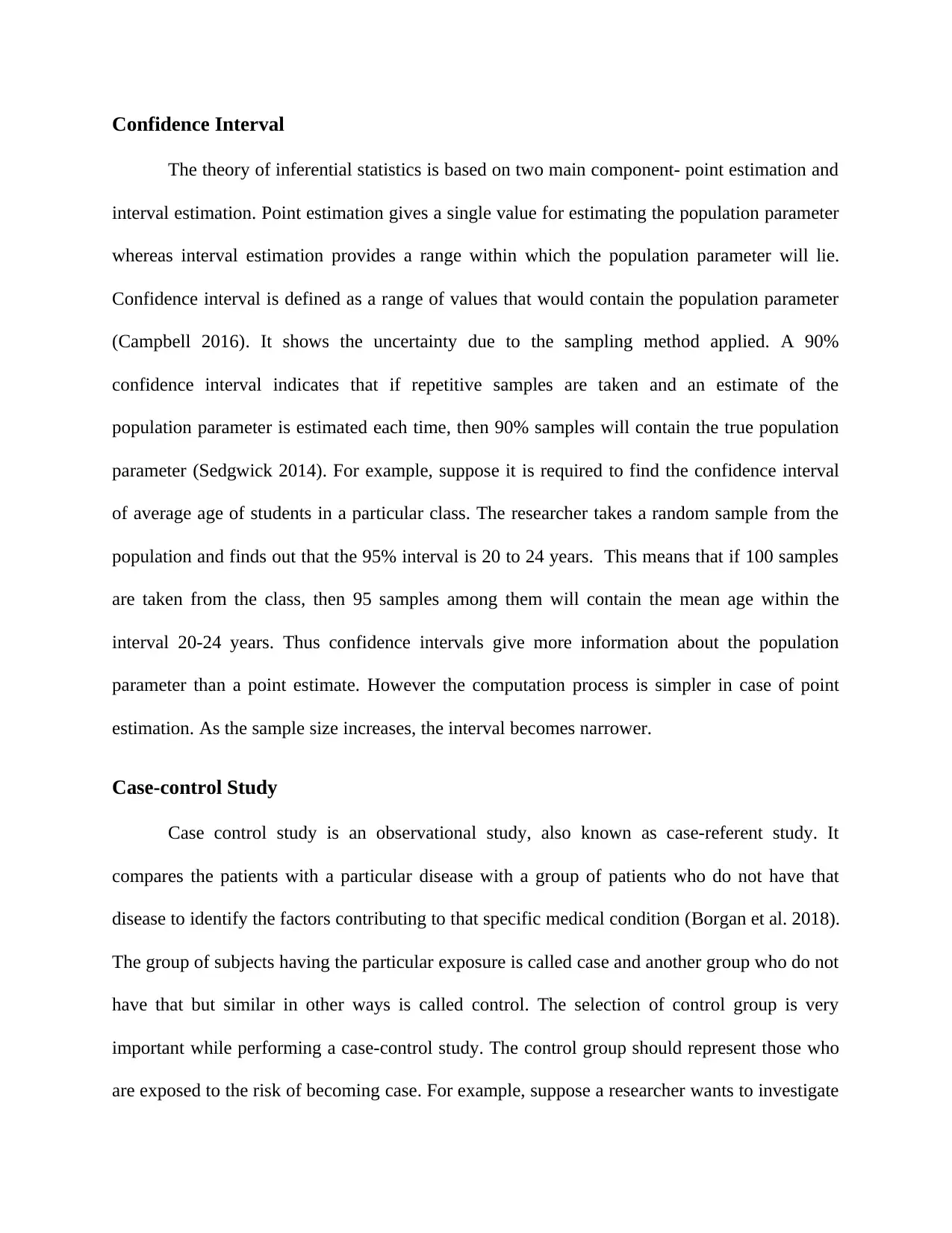
Confidence Interval
The theory of inferential statistics is based on two main component- point estimation and
interval estimation. Point estimation gives a single value for estimating the population parameter
whereas interval estimation provides a range within which the population parameter will lie.
Confidence interval is defined as a range of values that would contain the population parameter
(Campbell 2016). It shows the uncertainty due to the sampling method applied. A 90%
confidence interval indicates that if repetitive samples are taken and an estimate of the
population parameter is estimated each time, then 90% samples will contain the true population
parameter (Sedgwick 2014). For example, suppose it is required to find the confidence interval
of average age of students in a particular class. The researcher takes a random sample from the
population and finds out that the 95% interval is 20 to 24 years. This means that if 100 samples
are taken from the class, then 95 samples among them will contain the mean age within the
interval 20-24 years. Thus confidence intervals give more information about the population
parameter than a point estimate. However the computation process is simpler in case of point
estimation. As the sample size increases, the interval becomes narrower.
Case-control Study
Case control study is an observational study, also known as case-referent study. It
compares the patients with a particular disease with a group of patients who do not have that
disease to identify the factors contributing to that specific medical condition (Borgan et al. 2018).
The group of subjects having the particular exposure is called case and another group who do not
have that but similar in other ways is called control. The selection of control group is very
important while performing a case-control study. The control group should represent those who
are exposed to the risk of becoming case. For example, suppose a researcher wants to investigate
The theory of inferential statistics is based on two main component- point estimation and
interval estimation. Point estimation gives a single value for estimating the population parameter
whereas interval estimation provides a range within which the population parameter will lie.
Confidence interval is defined as a range of values that would contain the population parameter
(Campbell 2016). It shows the uncertainty due to the sampling method applied. A 90%
confidence interval indicates that if repetitive samples are taken and an estimate of the
population parameter is estimated each time, then 90% samples will contain the true population
parameter (Sedgwick 2014). For example, suppose it is required to find the confidence interval
of average age of students in a particular class. The researcher takes a random sample from the
population and finds out that the 95% interval is 20 to 24 years. This means that if 100 samples
are taken from the class, then 95 samples among them will contain the mean age within the
interval 20-24 years. Thus confidence intervals give more information about the population
parameter than a point estimate. However the computation process is simpler in case of point
estimation. As the sample size increases, the interval becomes narrower.
Case-control Study
Case control study is an observational study, also known as case-referent study. It
compares the patients with a particular disease with a group of patients who do not have that
disease to identify the factors contributing to that specific medical condition (Borgan et al. 2018).
The group of subjects having the particular exposure is called case and another group who do not
have that but similar in other ways is called control. The selection of control group is very
important while performing a case-control study. The control group should represent those who
are exposed to the risk of becoming case. For example, suppose a researcher wants to investigate
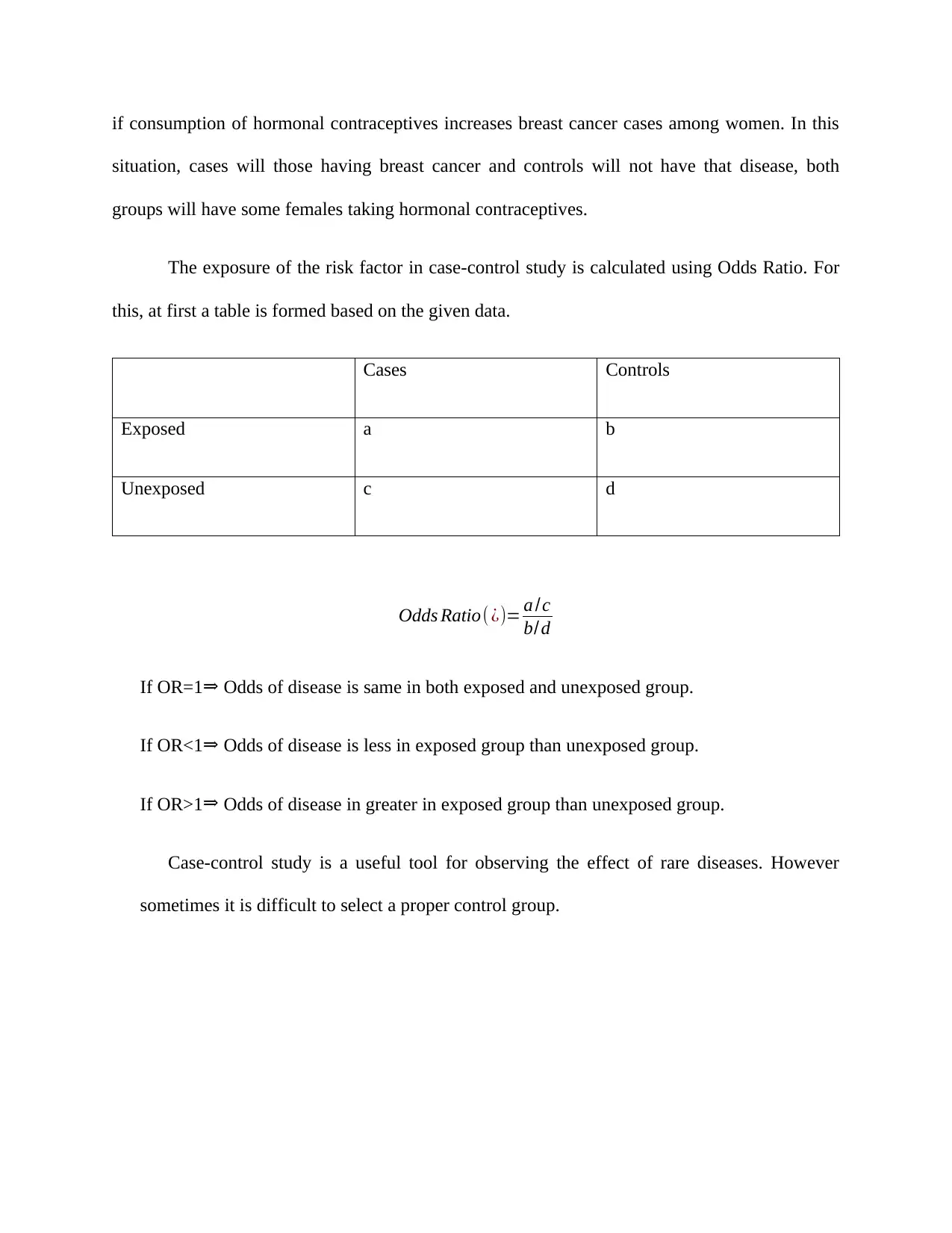
if consumption of hormonal contraceptives increases breast cancer cases among women. In this
situation, cases will those having breast cancer and controls will not have that disease, both
groups will have some females taking hormonal contraceptives.
The exposure of the risk factor in case-control study is calculated using Odds Ratio. For
this, at first a table is formed based on the given data.
Cases Controls
Exposed a b
Unexposed c d
Odds Ratio( ¿)= a /c
b/d
If OR=1 ⇒ Odds of disease is same in both exposed and unexposed group.
If OR<1 ⇒ Odds of disease is less in exposed group than unexposed group.
If OR>1 ⇒ Odds of disease in greater in exposed group than unexposed group.
Case-control study is a useful tool for observing the effect of rare diseases. However
sometimes it is difficult to select a proper control group.
situation, cases will those having breast cancer and controls will not have that disease, both
groups will have some females taking hormonal contraceptives.
The exposure of the risk factor in case-control study is calculated using Odds Ratio. For
this, at first a table is formed based on the given data.
Cases Controls
Exposed a b
Unexposed c d
Odds Ratio( ¿)= a /c
b/d
If OR=1 ⇒ Odds of disease is same in both exposed and unexposed group.
If OR<1 ⇒ Odds of disease is less in exposed group than unexposed group.
If OR>1 ⇒ Odds of disease in greater in exposed group than unexposed group.
Case-control study is a useful tool for observing the effect of rare diseases. However
sometimes it is difficult to select a proper control group.
⊘ This is a preview!⊘
Do you want full access?
Subscribe today to unlock all pages.

Trusted by 1+ million students worldwide
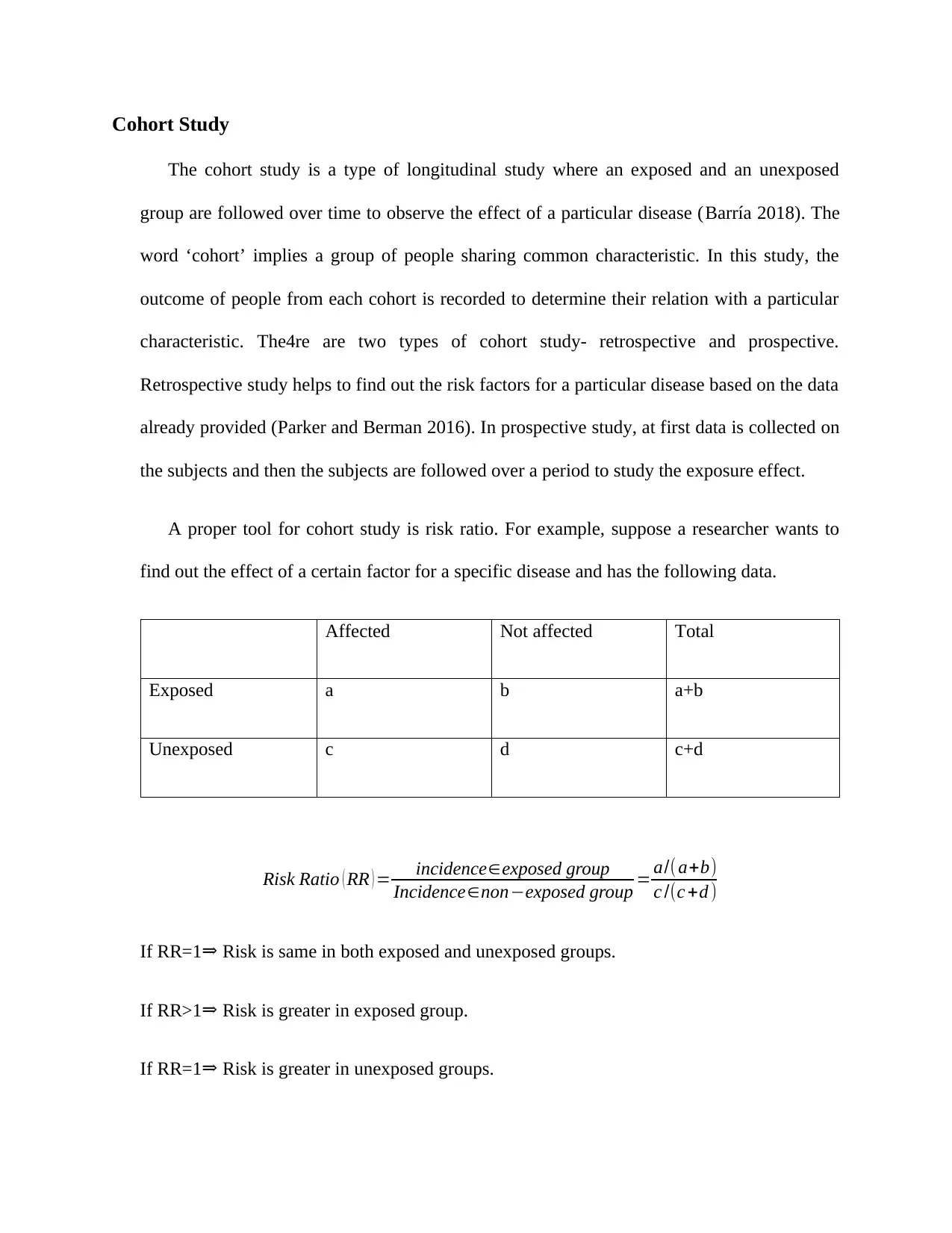
Cohort Study
The cohort study is a type of longitudinal study where an exposed and an unexposed
group are followed over time to observe the effect of a particular disease (Barría 2018). The
word ‘cohort’ implies a group of people sharing common characteristic. In this study, the
outcome of people from each cohort is recorded to determine their relation with a particular
characteristic. The4re are two types of cohort study- retrospective and prospective.
Retrospective study helps to find out the risk factors for a particular disease based on the data
already provided (Parker and Berman 2016). In prospective study, at first data is collected on
the subjects and then the subjects are followed over a period to study the exposure effect.
A proper tool for cohort study is risk ratio. For example, suppose a researcher wants to
find out the effect of a certain factor for a specific disease and has the following data.
Affected Not affected Total
Exposed a b a+b
Unexposed c d c+d
Risk Ratio ( RR ) = incidence∈exposed group
Incidence∈non−exposed group = a/( a+b)
c /(c +d )
If RR=1⇒ Risk is same in both exposed and unexposed groups.
If RR>1⇒ Risk is greater in exposed group.
If RR=1⇒ Risk is greater in unexposed groups.
The cohort study is a type of longitudinal study where an exposed and an unexposed
group are followed over time to observe the effect of a particular disease (Barría 2018). The
word ‘cohort’ implies a group of people sharing common characteristic. In this study, the
outcome of people from each cohort is recorded to determine their relation with a particular
characteristic. The4re are two types of cohort study- retrospective and prospective.
Retrospective study helps to find out the risk factors for a particular disease based on the data
already provided (Parker and Berman 2016). In prospective study, at first data is collected on
the subjects and then the subjects are followed over a period to study the exposure effect.
A proper tool for cohort study is risk ratio. For example, suppose a researcher wants to
find out the effect of a certain factor for a specific disease and has the following data.
Affected Not affected Total
Exposed a b a+b
Unexposed c d c+d
Risk Ratio ( RR ) = incidence∈exposed group
Incidence∈non−exposed group = a/( a+b)
c /(c +d )
If RR=1⇒ Risk is same in both exposed and unexposed groups.
If RR>1⇒ Risk is greater in exposed group.
If RR=1⇒ Risk is greater in unexposed groups.
Paraphrase This Document
Need a fresh take? Get an instant paraphrase of this document with our AI Paraphraser

The main advantage of a cohort study is the reduction of effect of confounding variables
since it uses matched subjects. Also the method is easier and cheaper. However, selection of
cohorts can be a difficult task.
since it uses matched subjects. Also the method is easier and cheaper. However, selection of
cohorts can be a difficult task.
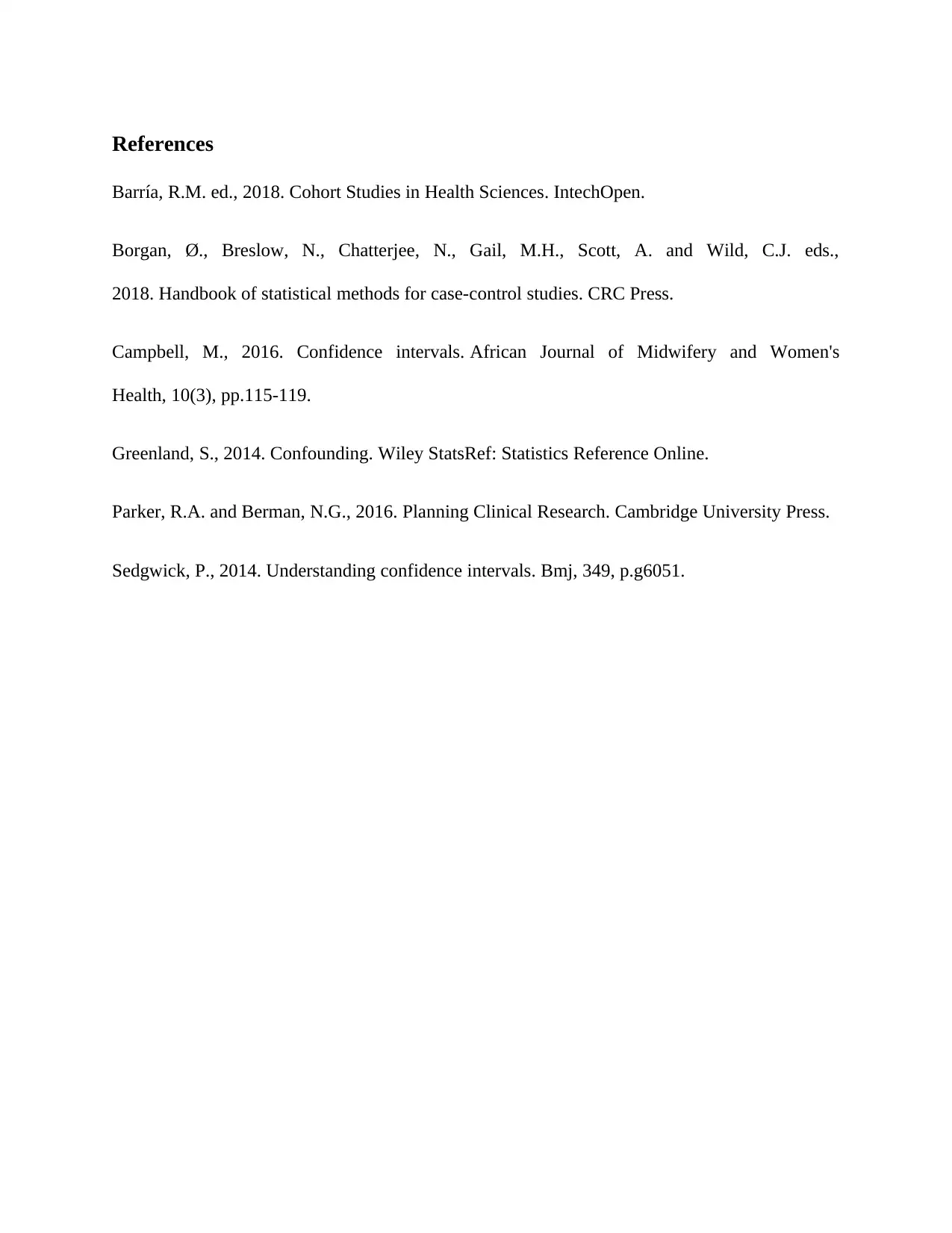
References
Barría, R.M. ed., 2018. Cohort Studies in Health Sciences. IntechOpen.
Borgan, Ø., Breslow, N., Chatterjee, N., Gail, M.H., Scott, A. and Wild, C.J. eds.,
2018. Handbook of statistical methods for case-control studies. CRC Press.
Campbell, M., 2016. Confidence intervals. African Journal of Midwifery and Women's
Health, 10(3), pp.115-119.
Greenland, S., 2014. Confounding. Wiley StatsRef: Statistics Reference Online.
Parker, R.A. and Berman, N.G., 2016. Planning Clinical Research. Cambridge University Press.
Sedgwick, P., 2014. Understanding confidence intervals. Bmj, 349, p.g6051.
Barría, R.M. ed., 2018. Cohort Studies in Health Sciences. IntechOpen.
Borgan, Ø., Breslow, N., Chatterjee, N., Gail, M.H., Scott, A. and Wild, C.J. eds.,
2018. Handbook of statistical methods for case-control studies. CRC Press.
Campbell, M., 2016. Confidence intervals. African Journal of Midwifery and Women's
Health, 10(3), pp.115-119.
Greenland, S., 2014. Confounding. Wiley StatsRef: Statistics Reference Online.
Parker, R.A. and Berman, N.G., 2016. Planning Clinical Research. Cambridge University Press.
Sedgwick, P., 2014. Understanding confidence intervals. Bmj, 349, p.g6051.
⊘ This is a preview!⊘
Do you want full access?
Subscribe today to unlock all pages.

Trusted by 1+ million students worldwide
1 out of 6
Related Documents
Your All-in-One AI-Powered Toolkit for Academic Success.
+13062052269
info@desklib.com
Available 24*7 on WhatsApp / Email
![[object Object]](/_next/static/media/star-bottom.7253800d.svg)
Unlock your academic potential
Copyright © 2020–2025 A2Z Services. All Rights Reserved. Developed and managed by ZUCOL.





